World Jewish News
Thomas Friedman explains how devastating Israel’s attacks on Iran have been

By BERNIE BELLAN I’m not sure how many readers follow Thomas Friedman’s writing in the New York Times; after all, he’s been highly critical of Netanyahu for years, which probably makes him persona non grata for a lot of you.
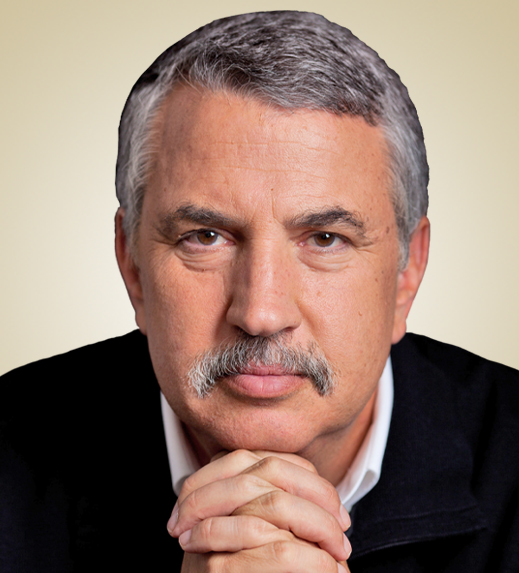
But, on Tuesday, November 26, Friedman wrote a piece that was so particularly incisive – and came across as so laudatory of what Israel has been able to achieve in the past 13 months, that even diehard Friedman critics should be able to take some very meaningful lessons away from that column.
Toward the beginning of what he wrote, Friedman makes what, for most readers of his columns, would probably be perceived as a fairly shocking statement when he writes: “In just the last two months, the Israeli military has inflicted a defeat on Iran that approaches its 1967 Six-Day War defeat of Egypt, Syria and Jordan. Full stop.”
He goes on to describe what Israel has been able to do to Hezbollah in the past few months as so destructive of that terrorist organization’s abilities that “Hezbollah and, by extension, Iran have decided to delink themselves from Hamas in Gaza and stop the firing from Lebanon for the first time since Oct. 8, 2023, the day after Hamas invaded Israel.”
Friedman then provides some very interesting information about how effective two attacks Israel launched against Iran – one in April and then one in October, were, both in inflicting tremendous damage to Iran’s capability to defend itself against a full scale Israeli attack – should one be launched, and in undermining Iran’s confidence that it can continue to arm Hezbollah without severe repercussions.
Here is what Friedman wrote:
“There is a reason for this (Hezbollah’s agreeing to a cease fire). Hezbollah’s mother ship has suffered a real blow. According to Prime Minister Benjamin Netanyahu, Israel’s April strike on Iran eliminated one of four Russian-supplied S-300 surface-to-air missile defense batteries around Tehran, and Israel destroyed the remaining three batteries on Oct. 26. Israel also damaged Iran’s ballistic missile production capabilities and its ability to produce the solid fuel used in long-range ballistic missiles. In addition, according to Axios, Israel’s Oct. 26 strike on Iran, which was a response to an earlier Iranian attack on Israel, also destroyed equipment used to create the explosives that surround uranium in a nuclear device, setting back Iran’s efforts in nuclear weapons research.
“A senior Israeli defense official told me that the Oct. 26 attack on Iran ‘was lethal, precise and a surprise.’ And up to now, the Iranians ‘don’t know technologically how we hit them. So they are at the most vulnerable point they have been in this generation: Hamas is not there for them, Hezbollah is not there for them, their air defenses are not there anymore, their ability to retaliate is sharply diminished, and they are worried about Trump.’ “
Friedman’s column goes on to offer advice to President-elect Trump how to deal with other changing realities in the world, including the rapid pace of artificial intelligence development in which, Friedman points out, Israelis are playing a leading role. But one has to wonder whether anyone in Trump’s circle bothers to read anything written by Friedman. After all, he was very close to President Biden – which would certainly put him into Trump’s enemies’ camp, on top of which he writes for that most hated of all media: The New York Times.
Still, if someone who is as critical of Israel’s government as Friedman has been is capable of pointing out the vastly changed dynamic now permeating the entire Middle East as a result of the huge blows Israel has inflicted both on Iran’s number one proxy in the region – Hezbollah, and on Iran itself, once can more readily understand how Israel’s strategy of taking on different enemies all at the same time has paid off.
I, for one, will admit that I was quite surprised to read Friedman’s analysis – and it leads me to question my own thoughts as to what would happen when Israel opened up a new front in Lebanon at the same time as it was still engaged in Gaza. I had thought that it might lead to a repeat of the 2006 debacle, in which a ground invasion by Israel into Lebanon led to heavy Israeli losses and what was, in effect, a victory for Hezbollah – not by being able to defeat Israel, but simply by surviving that invasion.
This time around though – and we’ll have to wait for military analysts to tell us just how effective the heavy Israeli bombardment of Lebanese areas has been in terms of degrading Hezbollah’s military capabilities, Israel has managed to keep its own casualties relatively low by relying upon bombing of Hezbollah infrastructure. As has been the case in Gaza, however, it’s so difficult to tell what those devastating bombings have actually accomplished in specific terms beyond realizing that they have thoroughly degraded both Hamas’s and Hezbollah’s military capacities. It seems though that the aphorism that “the sum is greater than its parts” is particularly apt in describing what the Israel Air Force has been able to achieve.
While we have been witnessing the wholesale destruction of civilian areas – in both Gaza and Lebanon, it now seems evident that Israeli intelligence has been able to locate terrorist locations with tremendous accuracy. The fact that both Hamas and Hezbollah have been so thoroughly embedded within civilian population areas made it inevitable that, once the IAF embarked upon a relentless campaign to destroy terrorist infrastructure and locations where terrorists were embedded within the civilian population, there would be huge civilian casualties – but ultimately Israel would be able to degrade both Hamas and Hezbollah’s fighting abilities to the point where they have both been neutralized in large part.
The question, of course, is what will now happen as a result of Friedman himself describing Israel’s having forced Hezbollah and Iran to “delink” themselves from Hamas. Hamas is, in effect, nothing more than a mafia type organization, now terrorizing the Palestinian population in Gaza, with its own survival now being its purpose. The Israel Defence Forces seem content to let Hamas carry on its campaign of looting aid trucks and terrorizing the population for its own benefit.
But Hamas fighters, however many may remain, don’t have the same option as Hezbollah’s fighters – which is to retreat behind a defined line north of the Litani River in Lebanon. How many are in the tunnels? How many are embedded within the rest of the Gaza population? If the IDF has an idea what the answers to those questions are, I haven’t seen them.
So, the war in Gaza will likely carry on for some time. It appears that the bombing campaign has thoroughly reduced Hamas’s ability to carry on any effective strikes on Israeli targets, but it is not clear at what point the Israeli government might be willing to accept any sort of a ceasefire. The government’s position has been that a ceasefire can only be entered into when at least the majority of the hostages are released, but frankly, Israel is now operating from such a position of strength vis-a-vis Hamas, that the idea of accepting a ceasefire that would allow Hamas fighters to remain in place seems unconscionable to the vast majority of Israelis. It may seem perverse to think that the government has been willing to sacrifice hostages’ lives for the sake of dealing a final, crushing blow to Hamas, but that’s the sad reality.
Still, who would have thought that Israel would be able to wage successful wars on so many fronts? As Thomas Friedman has noted, Israel has upended the situation in the Middle East, albeit at a very heavy price. And even though I’ve been questioning from the outset the Israeli government’s strategy of seeking total victory over Hamas, given how thoroughly Israel has been able to undermine Hezbollah’s and Iran’s positions, perhaps I was wrong to question Netanyahu’s goal of thoroughly crushing Hamas. Credit has to be given though to the IDF and how much they learned from previous wars with Hamas and Hezbollah.
Amidst all this though, one has to feel great sympathy for the people of Gaza. They are being held to ransom by a gang of thugs and there does not appear to be any way out for them. For their sake, let’s hope that Israel can “finish the job” quickly, although how that can be done remains difficult to know. Perhaps Thomas Friedman, who is always so thoughtful and insightful, can shed some answers to that question as well.
World Jewish News
How the Global Religious Landscape Changed from 2010 to 2020

Muslims grew fastest; Christians lagged behind global population increase
• Christians are the world’s largest religious group, at 28.8% of the global population. They are a majority everywhere except the Asia-Pacific and Middle East-North Africa regions. Sub-Saharan Africa has surpassed Europe in having the largest number of Christians. But Christians are shrinking as a share of the global population, as millions of Christians “switch” out of religion to become religiously unaffiliated.
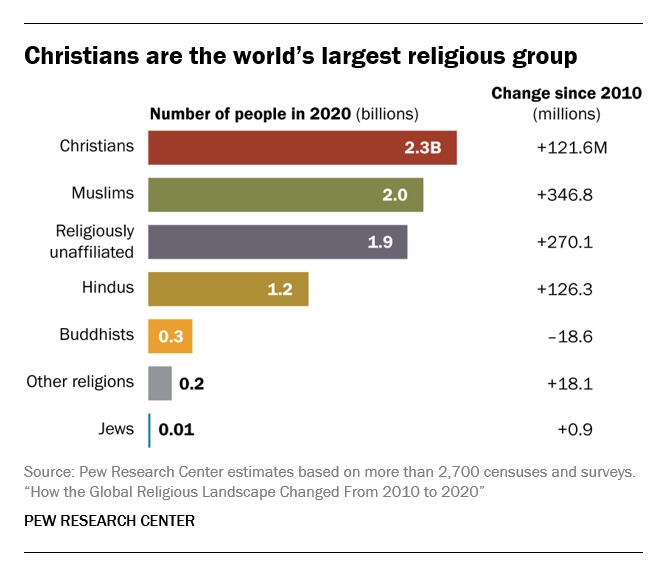
• Muslims are the world’s second-largest religious group (25.6% of the world’s population) and the fastest-growing major religion, largely due to Muslims’ relatively young age structure and high fertility rate. They make up the vast majority of the population in the Middle East-North Africa region. In all other regions, Muslims are a religious minority, including in the Asia-Pacific region (which is home to the greatest number of Muslims).
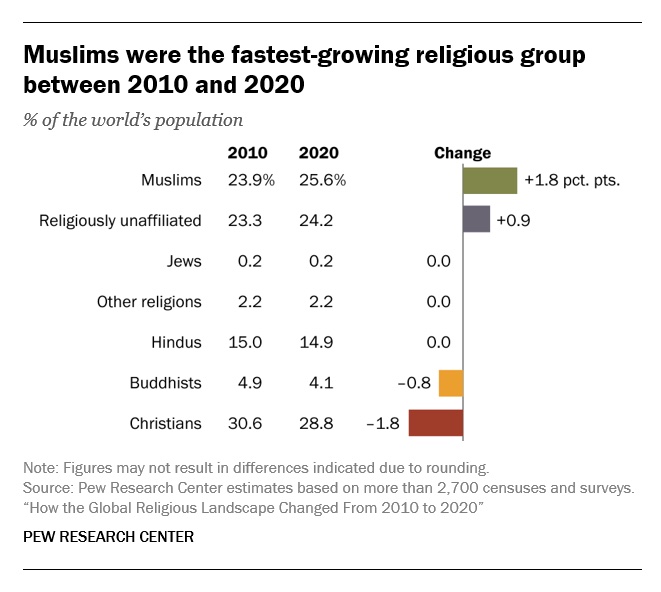
• The religiously unaffiliated population is the world’s third-largest religious category (24.2% of the global population), after Christians and Muslims. Between 2010 and 2020, religiously unaffiliated people grew more than any group except Muslims, despite their demographic disadvantages of an older age structure and relatively low fertility. The unaffiliated made up a majority of the population in 10 countries and territories in 2020, up from seven a decade earlier.
• Hindus are the fourth-largest religious category (14.9% of the world’s population), after Christians, Muslims and religiously unaffiliated people. Most (99%) live in the Asia-Pacific region; 95% of all Hindus live in India alone. Between 2010 and 2020, Hindus remained a stable share of the world’s population because their fertility resembles the global average, and surveys indicate that switching out of or into Hinduism is rare.
• Buddhists (4.1% of the world’s population) are the only group in this report whose number declined worldwide between 2010 and 2020. This was due both to religious disaffiliation among Buddhists in East Asia and to a relatively low birth rate among Buddhists, who tend to live in countries with older populations. Most of the world’s Buddhists (98%) reside in the Asia-Pacific region, the birthplace of Buddhism.
• Jews, the smallest religious group analyzed separately in this report (0.2% of the world’s population), lagged behind global population growth between 2010 and 2020 – despite having fertility rates on par with the global average – due to their older age structure. Most Jews live either in North America (primarily in the United States) or in the Middle East-North Africa region (almost exclusively in Israel).
These are among the key findings of a Pew Research Center analysis of more than 2,700 censuses and surveys, including census data releases that were delayed due to the coronavirus pandemic. This report is part of the Pew-Templeton Global Religious Futures project, which analyzes global religious change and its impact on societies around the world. Funding for the Global Religious Futures project comes from The Pew Charitable Trusts and the John Templeton Foundation.
World Jewish News
Antisemitism in some unlikely places in America

By HENRY SREBRNIK Antisemitism flourishes in a place where few might expect to confront it – medical schools and among doctors. It affects Jews, I think, more emotionally than Judeophobia in other fields.
Medicine has long been a Jewish profession with a history going back centuries. We all know the jokes about “my son – now also my daughter – the doctor.” Physicians take the Hippocratic Oath to heal the sick, regardless of their ethnicity or religion. When we are ill doctors often become the people who save us from debilitating illness and even death. So this is all the more shocking.
Yes, in earlier periods there were medical schools with quotas and hospitals who refused or limited the number of Jews they allowed to be affiliated with them. It’s why we built Jewish hospitals and practices. And of course, we all shudder at the history of Nazi doctors and euthanasia in Germany and in the concentration camps of Europe. But all this – so we thought – was a thing of a dark past. Yet now it has made a comeback, along with many other horrors we assume might never reappear.
Since the Hamas attack on Israel on October 7, 2023, there has been a resurgence of antisemitism, also noticeable in the world of healthcare. This is not just a Canadian issue. Two articles on the Jewish website Tablet, published Nov. 21, 2023, and May 18, 2025, spoke to this problem in American medicine as well, referencing a study by Ian Kingsbury and Jay P. Greene of Do No Harm, a health care advocacy group, based on data amassed by the organization Stop Antisemitism. They identified a wave of open Jew-hatred by medical professionals, medical schools, and professional associations, often driven by foreign-trained doctors importing the Jew-hatred of their native countries, suggesting “that a field entrusted with healing is becoming a licensed purveyor of hatred.”
Activists from Doctors Against Genocide, American Palestinian Women’s Association, and CODEPINK held a demonstration calling for an immediate cease-fire in Gaza at the Hart Senate Office Building in Washington, D.C., Nov. 16, 2023, almost as soon as the war began. A doctor in Tampa took to social media to post a Palestinian flag with the caption “about time!!!” The medical director of a cancer centre in Dearborn, Michigan, posted on social media: “What a beautiful morning. What a beautiful day.” Even in New York, a physician commented on Instagram that “Zionist settlers” got “a taste of their own medicine.” A Boston-based dentist was filmed ripping down posters of Israeli victims and a professor at the University of Pennsylvania Perelman School of Medicine did the same. Almost three-quarters of American medical associations felt the need to speak out on the war in Ukraine but almost three-quarters had nothing to say about the war in Israel.
Antisemitism in academic medical centres is fostering noxious environments which deprive Jewish healthcare professionals of their civil right to work in spaces free from discrimination and hate, according to a study by the Data & Analytics Department of StandWithUs, an international, non-partisan education organization that supports Israel and fights antisemitism.
“Academia today is increasingly cultivating an environment which is hostile to Jews, as well as members of other religious and ethnic groups,” StandWithUs director of data and analytics, and study co-author, Alexandra Fishman, said on May 5 in a press release. “Academic institutions should be upholding the integrity of scholarship, prioritizing civil discourse, rather than allowing bias or personal agendas to guide academic culture.”
The study, “Antisemitism in American Healthcare: The Role of Workplace Environment,” included survey data showing that 62.8 per cent of Jewish healthcare professionals employed by campus-based medical centres reported experiencing antisemitism, a far higher rate than those working in private practice and community hospitals. Fueling the rise in hate, it added, were repeated failures of DEI (diversity, equity, and inclusion) initiatives to educate workers about antisemitism, increasing, the report said, the likelihood of antisemitic activity.
“When administrators and colleagues understand what antisemitism looks like, it clearly correlates with less antisemitism in the workplace,” co-author and Yeshiva University professor Dr. Charles Auerbach reported. “Recognition is a powerful tool — institutions that foster awareness create safer, more inclusive environments for everyone.”
Last December, the Data & Analytics Department also published a study which found that nearly 40 per cent of Jewish American health-care professionals have encountered antisemitism in the workplace, either as witnesses or victims. The study included a survey of 645 Jewish health workers, a substantial number of whom said they were subject to “social and professional isolation.” The problem left more than one quarter of the survey cohort, 26.4 per cent, “feeling unsafe or threatened.”
The official journal of the Alliance for Academic Internal Medicine concurs. According to “The Moral Imperative of Countering Antisemitism in US Medicine – A Way Forward,” by Hedy S. Wald and Steven Roth, published in the October 2024 issue of the American Journal of Medicine, increased antisemitism in the United States has created a hostile learning and practice environment in medical settings. This includes instances of antisemitic behaviour and the use of antisemitic symbols at medical school commencements.
Examples of its impact upon medicine include medical students’ social media postings claiming that Jews wield disproportionate power, antisemitic slogans at the University of California, Los Angeles (UCLA) David Geffen School of Medicine, antisemitic graffiti at the University of California, San Francisco (UCSF) Cancer Centre, Jewish medical students’ exposure to demonization of Israel diatribes and rationalizing terrorism; and faculty, including a professor of medicine at UCSF, posting antisemitic tropes and derogatory comments about Jewish health care professionals. Jewish medical students’ fears of retribution, should they speak out, have been reported. “Our recent unpublished survey of Jewish physicians and trainees demonstrated a twofold increase from 40% to 88% for those who experienced antisemitism prior to vs after October 7,” they stated.
In some schools, Jewish faculty are speaking out. In February, the Jewish Faculty Resilience Group at UCLA accused the institution in an open letter of “ignoring” antisemitism at the School of Medicine, charging that its indifference to the matter “continues to encourage more antisemitism.” It added that discrimination at the medical school has caused demonstrable harm to Jewish students and faculty. Student clubs, it said, are denied recognition for arbitrary reasons; Jewish faculty whose ethnic backgrounds were previously unknown are purged from the payrolls upon being identified as Jews; and anyone who refuses to participate in anti-Zionist events is “intimidated” and pressured.
Given these findings, many American physicians are worried not only as Jewish doctors and professionals, but for Jewish patients who are more than ever concerned with whom they’re meeting. Can we really conceive of a future where you’re not sure if “the doctor will hate you now?”
Henry Srebrnik is a professor of political science at the University of Prince Edward Island.
World Jewish News
The 2025 Toronto Walk (and talk ) for Israel
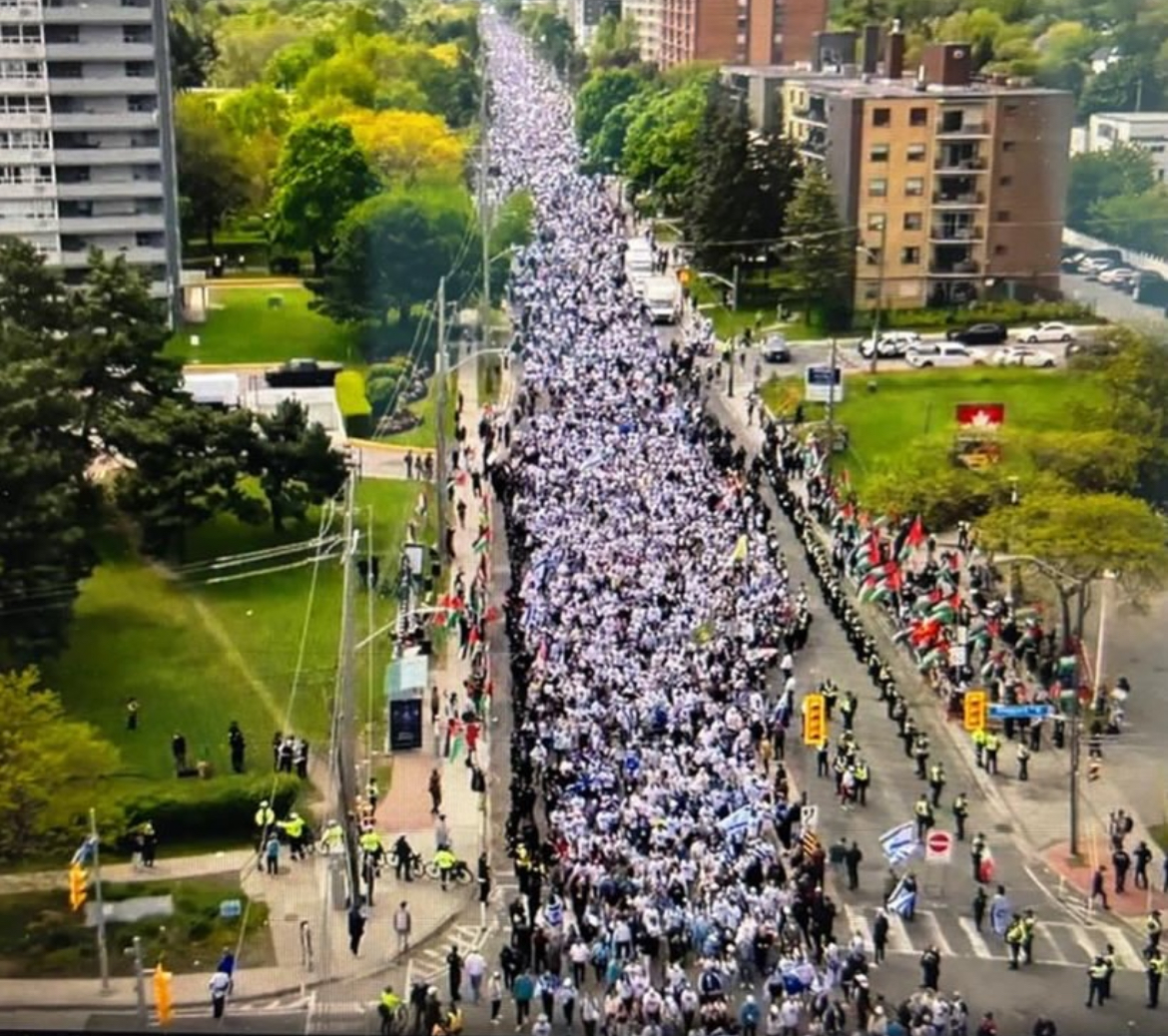
By GERRY POSNER There are walks and then there are walks. The Toronto UJA Walk for Israel on May 25, 2025 was one of a kind, at least as far as Canada and Jews are concerned. The number of people present was estimated to be 56,000 people or 112,000 total shoes. (How they get to that number is bewildering to me, since there is no one counting). This was 6,000 more than last year. Whether it is true or not, take it from me, it was packed. The synagogues in Canada should be so fortunate to get those numbers in total on High Holidays. The picture here gives you a sense of the size of the crowd.

This was my first walk in Toronto for Israel and I was with my granddaughter, Samantha Pyzer (not to forget her two friends whom she managed to meet at the site, no small feat, even with iPhones as aids). The official proceedings began at 9:00 a.m. and the walk at 10:00 a.m. There was entertainment to begin with, also along the way, and at the finish as well. The finish line this year was the Prosserman Centre or the JCC as it often called. The walk itself was perhaps 4 kilometres – not very long, but the walking was slow, especially at the beginning. There were lots of strollers, even baby carriages, though I did not see any wheelchairs. All ages participated on this walk. I figured, based on what I could see on the faces of people all around me that, although I was not the oldest one on the walk, I bet I made the top 100 – more likely the top 20.
What was a highlight for me was the number of Winnipeggers I met, both past and present. Connecting with them seemed to be much like a fluke. No doubt, I missed la lot of them, but I saw, in no particular order (I could not recall the order if my life depended on it): Alta Sigesmund, (who was, a long time ago, my daughter Amira’s teacher), Marni Samphir, Karla Berbrayer and her husband Dr. Allan Kraut and family. Then, when Samantha and I made it to the end and sat down to eat, I struck up a conversation with a woman unknown to me and as we chatted, she confirmed her former Winnipeg status as a sister-in- law to David Devere, as in Betty Shwemer, the sister of Cecile Devere. I also chanced upon Terri Cherniack, only because I paused for a moment and she spotted me. As we closed in near the finish, I met ( hey were on their way back), Earl and Suzanne Golden and son Matthew, as well as Daniel Glazerman. That stop caused me to lose my granddaughter and her pals. Try finding them amid the noise and size of the crowd – but I pulled it off.
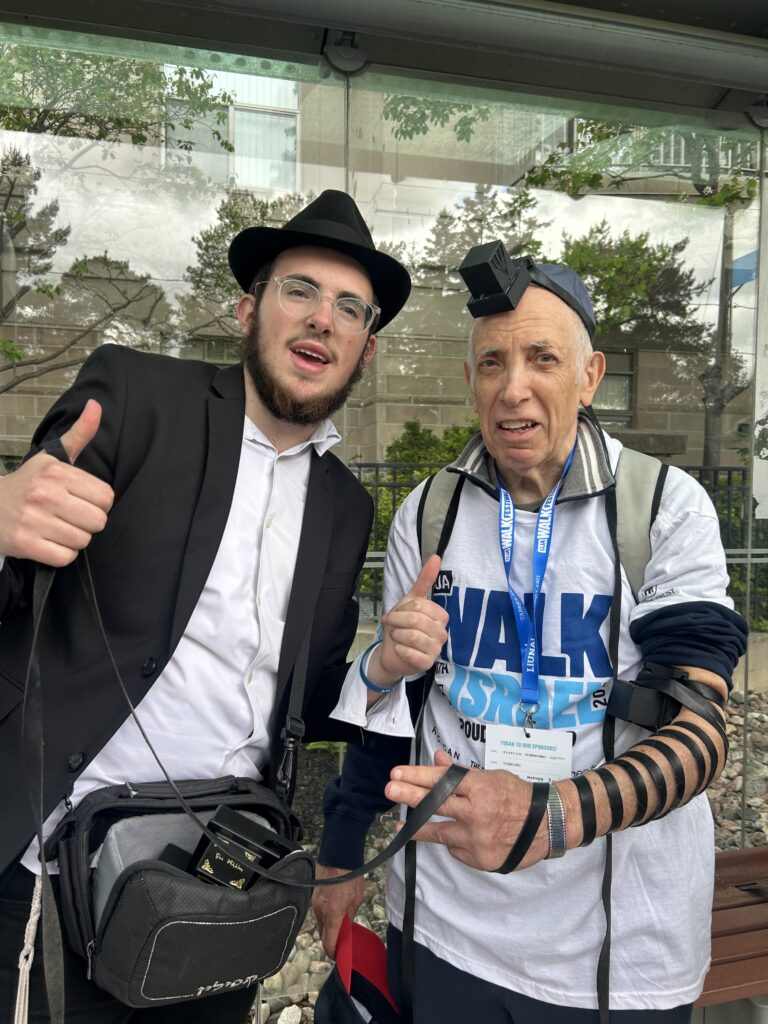
As I was in line to get food, I started chatting with a guy in the vicinity of my age. I dropped the Winnipeg link and the floodgates opened with “ Did I know Jack and Joanie Rusen?” So that was an interesting few minutes. And I was not too terribly surprised to come across some of my Pickleball family. All of these meetings, along with spotting some of my sister’s family and other cousins, were carried on with the sound of the shofar as we moved along the way. In short, this was a happening. Merchants selling a variety of products, many of them Israeli based, were in evidence and, of course, the day could not have ended without the laying of tefillin, aided by Chabad, who have perfected the procedure to take less than a minute. See the photo. Chabad had a willing audience.
Aside from the joy of sharing this experience with my granddaughter, the very presence of all these Jews gathered together for a common reason made this day very special to me. However, there was a downside to the day. The downside was that, as we began to walk back to our car there was no other way I could figure out how to return when the rains came and came. While we walked faster, we were impeded by pouring rain and puddles. But Samantha wanted to persevere, as did I. We made it, but were drenched. My runners are still drying out as I write this two days later.
What with being surrounded by 56,000 people, the noise, the slow walking, and the rain, I can still say the day was a real highlight for me – one of the better moments since our arrival in Toronto in 2012. As well as the photos we took along the way, I have the reminder of the day, courtesy of the UJA, as evidenced from the photo. It was not just the walk, but the talk that accompanied the walk that made it so worthwhile for me. I would do it again, minus the rain.
